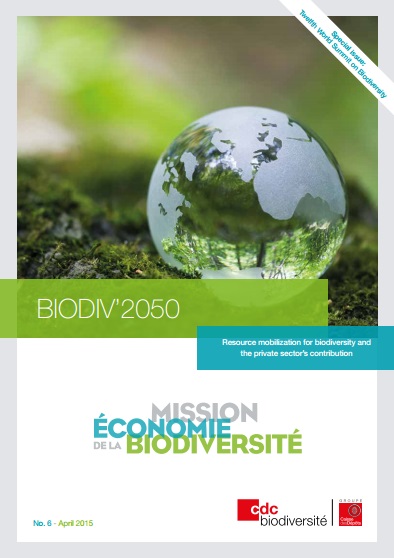 As I have already announced in my latest post, the latest issue of Mission Économie de la Biodiversité’s “BIODIV’2050″ (No. 6 — April 2015) is out. Beside the previously mentioned article entitled “Thinking out the appropriate frameworks: biodiversity offsets and safeguards” another article asks “HOW CAN THE PRIVATE SECTOR CONTRIBUTE TO RESOURCE MOBILIZATION TO REACH THE AICHI TARGETS?” It is highlighted that there is a lack of international consensus on the participation of the private sector and on the financing mechanisms, e.g. with regard to the “commodification of nature”:
As I have already announced in my latest post, the latest issue of Mission Économie de la Biodiversité’s “BIODIV’2050″ (No. 6 — April 2015) is out. Beside the previously mentioned article entitled “Thinking out the appropriate frameworks: biodiversity offsets and safeguards” another article asks “HOW CAN THE PRIVATE SECTOR CONTRIBUTE TO RESOURCE MOBILIZATION TO REACH THE AICHI TARGETS?” It is highlighted that there is a lack of international consensus on the participation of the private sector and on the financing mechanisms, e.g. with regard to the “commodification of nature”:
The commodification of nature?
The economic approach to biodiversity, the mobilization of innovative financial mechanisms and the involvement of businesses in natural capital conservation are controversial issues. One argument is that these approaches may lead to the commodification of nature, the creation of biodiversity markets and/or the appropriation of nature by the private sector. In other words, species, habitats and ecosystem services would be assimilated to merchandise, like any other, and would be monetized at the daily rate to be “bought” or “sold” by companies or financial institutions speculating for profit. But this vision is far from reality on the ground.
Paying a physician does not imply commodifying health. Paying compensation in case of a life-threatening accident does not mean putting a price tag on human life. Similarly, calculating the economic value of biodiversity does not mean pricing its value.
Economic valuation of biodiversity aims at recognising that biodiversity is useful and rare, and that decisions, (public or private) concerning territorial development or production have been taken up to now without giving sufficient heed to the value of biodiversity and hence has been detrimental to the ecosystems on which the economic activities depend. The vision of nature adopted in this approach, thus, is very anthropocentric. However it doesn’t not imply the “pricing” of species for sale on any market driven by supply and demand. And were such “markets” ever to exist, standard economic theory tells us that for public goods such as biodiversity or ecosystem services, markets of this type would not be effective.
With regard to economic instruments, often assimilated to so-called market-based instruments, experience, here again, is far different from prejudicial opinions, one way or the other. In the case of biodiversity offsets or payments for environmental services (PES) for instance, it is not the species or the ecosystem services, which by definition cannot be appropriated, that are bought or sold, but rather the conservation or restoration actions that bring about changes in practices on lands where people have user rights. Quite contrary to the idea of commodification, when these actions are connected to the introduction of conservation easements, privately-owned lands, in a way, could been seen as being part again of the public domain serving general interest. Furthermore, the context of implementation of those instruments is strictly regulated by public authorities, guarantors of the robustness of defined conservation and restoration actions, as defined and implemented.
Last, businesses that engage in biodiversity action are mostly encouraged to incorporate the value of ecosystem services in their decision-making process in order to recognise the impact and dependence of their activities on biodiversity. The primary goal here is to limit the cost of these activities to society and construct business models that combine development and biodiversity conservation.
You can read the article and download the full issue here (open access). For more information see also the abstract and table of contents of the issue below.
Abstract of the issue
The current international situation offers us a robust, potentially promising framework that is well adapted to a variety of approaches. But due to insufficient investments and financial resources it cannot be well implemented and the Aichi biodiversity targets, that aim to put an end to biodiversity degradation by the year 2020, are still far away. The challenges and stakes of biodiversity need to be made better known and integrated at all levels. Because of this situation, business entities are in the front line. They have the technical and financial ability to contribute to this collective momentum, and their contributions may often be a source of opportunity. Furthermore, strong social demand is driving businesses – provided that a coherent framework be put in place – toward biodiversity-enhancing development.
Table of contents of the issue
CHALLENGES 4
The Convention on Biological Diversity: stakes, challenges and prospects stemming from the COP12
- The international community focuses on biodiversity by creating a robust yet complex mechanism
- Resources assessment and mobilization: lessons learned from COP12
OPINION 10
Strategy for resource mobilization: stakes, challenges and the private sector’s contribution
Interview with Carlos Manuel Rodriguez — Chairman of the CBD High-Level Panel on Global Assessment of Resources — and Dr. Naoko Ishii — CEO and Chairperson of the Global Environment Facility.
UNDERSTANDING 15
How can the private sector contribute to resource mobilization to reach the Aichi targets?
- Mobilizing resources to achieve the Aichi Targets: what are the stakes?
- How does the private sector contribute to resource mobilization?
- Private sector investment for resource mobilization: barriers and drivers
OPINION 24
The role of economic valuation of ecosystem services and biodiversity in resource mobilization and private sector involvement
Interview with Pavan Sukhdev — Fouder-CEO of GIST Advisory.
INVENTING 27
Thinking out the appropriate frameworks: biodiversity offsets and safeguards
